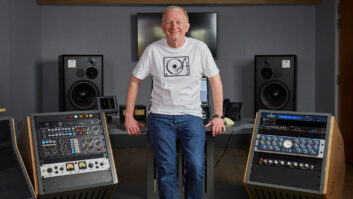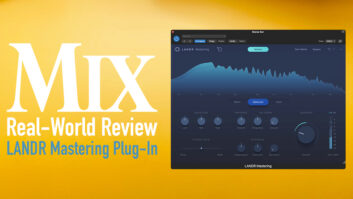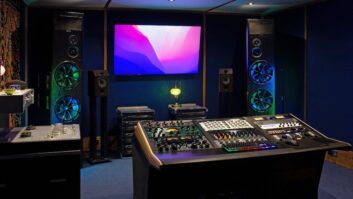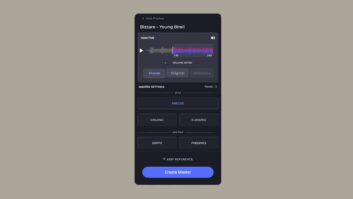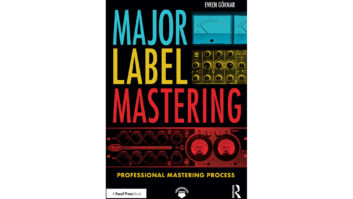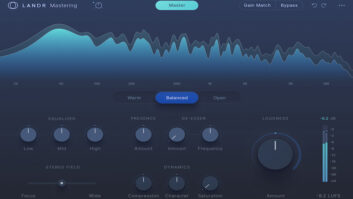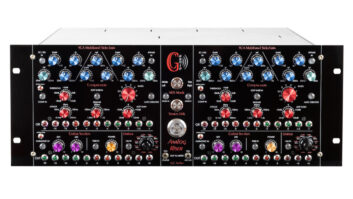Even though there is still ample uncertainty about how the 5.1-channel revolution will play out in the marketplace — with format confusion chief among the obstacles — mastering engineers who have been working in the medium since its inception have learned many lessons about how to best deliver their clients’ multichannel projects to the home theater.
Three of the top engineers — Bob Ludwig, Denny Purcell and Stephen Marcussen — took time to share their views with Mix about the aesthetics, logistics and technical aspects of surround. Each of our interviewees is an engineer/facility owner whose body of work represents the state-of-the-art in 5.1-channel mastering.
Bob Ludwig’s Gateway Mastering and DVD in Portland, Maine, was already renowned as one of the world’s leading music mastering houses when Ludwig decided, early on, to take the plunge into DVD and, later, Super Audio CD. Like his counterparts in the audio mastering business, Ludwig took a no-holds-barred approach to audio integrity, sparing no expense in his quest for the ultimate sound. However, unlike the vast majority of music specialists, Ludwig also embraced the visual and interactive side of the DVD experience with an authoring department headed by Brian Lee, who has been at Gateway since soon after the studio opened in 1993.
Similarly, Purcell’s Georgetown Mastering in Nashville has a reputation for turning out some of the most acclaimed music recordings in the business, with clients including Neil Young, Mark Knopfler, the Dixie Chicks, and a host of other rock, pop and country stars. An early believer in the power of surround sound, Purcell was instrumental in setting high audio standards for the DVD-Audio specification. He also has been a key proponent of DTS, both in its initial CD incarnation and in its current DVD-based version.
Los Angeles-based Marcussen — who recently opened an eponymous studio after serving for two decades at Precision Mastering, and then operating briefly out of the now-defunct A&M Mastering Studios — is a relentlessly musical engineer whose clientele reflects his commitment to quality: e.g., Johnny Cash, Alice in Chains and Tom Petty. Having experimented with DVD mastering at A&M, Marcussen built his new room as a surround environment (this month’s cover), and has since done a significant amount of DVD-Audio and DVD-Video work.
Creatively and technically, Ludwig, Purcell and Marcussen have different preferences and methods. However, they share a passion for the 5.1 experience and a belief that surround is here to stay, notwithstanding some of the technical and marketing hurdles that stand in its way.
“There’s never been a doubt in my mind that surround is going to make it because of the success of DVD-Video,” says Ludwig. “More and more, people are going to start putting in home theater systems. There is a hell of a lot of Dolby chips out there. Unlike quad, where there were a lot of reasons why it didn’t succeed, including sound quality and technical reasons, there are enough numbers with DVD that this isn’t going to go away.”
Having said that, Ludwig is quick to share his concerns about the various surround formats. As far as DVD-Video is concerned, Ludwig is less-than-thrilled about the format’s audio limitations, which necessitate the use of lossy compression systems in order to deliver six discrete channels.
“The lossy compression systems, Dolby Digital and DTS, are similar to [Sony’s] ATRAC, in that they can’t be compensated for because it’s a resolution situation,” says Ludwig. “It’s like saying, here’s a cassette, make it sound like a 30 ips half-inch tape. There’s no knob you can use that’ll do that.”
He adds, “From a frequency response standpoint, they’re both pretty good. We did a test where we ran compressed and uncompressed data into a frequency analyzer. When you subtract the two waveforms, you get a flat line.”
Despite his reservations about lossy compression, Ludwig has no choice but to use it, because at least 50% of the DVDs he masters are released on DVD-Video. The rest are coming out on DVD-Audio, which allows for six discrete channels of uncompressed audio. (Technically, the audio is compressed, but the algorithm that is used, Meridian Lossless Packing, is “lossless,” i.e., bit-for-bit identical at the input and output.) For more on Ludwig’s views on DVD-A and much more, flip to “Mix Interview,” page 56.
Purcell, too, has done a broad range of projects in a variety of formats, including DVD-Video (using DTS and Dolby compression), DVD-Audio and DTS’ proprietary CD-sound carrier. Among his credits are Vince Gill’s High Lonesome Sound, Mark Knopfler’s Sailing to Philadelphia, Van Morrison’s Moondance, titles by the Doobie Brothers and America, and Neil Young’s Harvest, which has yet to be released.
Purcell has carved out a niche as a DTS specialist, first with the early CD-based version of the format, and now with the DVD permutation. However, despite his sonic preference for DTS, Purcell advises all program developers to put Dolby AC3 bitstreams on their DVDs. “Thirty million players can’t be wrong,” he says, referring to the installed user base of Dolby-equipped DVD players.
Compression or no compression, DVDs have captivated the hearts of music fans — and engineers — because the surround experience is compelling unto itself, according to Marcussen. He says, “When you hear some of these DVDs, they sound great. You have this plane of sound that has a tremendous amount of dimension.”
From a professional’s standpoint, too, the bigger canvas has opened up new creative possibilities. “Creatively, it’s interesting, because you don’t have to be as aggressive as far as levels go,” says Marcussen. “I’m sure levels will inch up over time, but I hope they don’t. It would be really tiring to be in the middle of something that’s pumped to the wall. One of the things I’ve learned is that less is really more. When you put yourself in that kind of landscape, it’s cool that things pop, and it’s cool that things get quiet.”
Marcussen uses five B&W 802 speakers to monitor the 5.1 projects he’s done, which include Alice in Chains’ Music Bank: The Videos, Hootie & The Blowfish’s Cracked Rear View, and a live DVD by Ringo Starr & His All-Star Band. Marcussen arranged the speakers according to the ITU spec, which calls for 30° angles for the front left and right speakers in relation to the sweet spot, and 110° angles for the rears.
“That configuration gives you a bigger sweet spot,” Marcussen explains. “When you’re sitting at the console, you can go a little off to either side and still hear a good left/right balance, or you can roll back in your chair and not be blown out by the rears.”
Purcell’s speaker placement is similar to Marcussen’s, if not more homespun. “I believe that three or four guys on a porch can come to clarity much more quickly than 20 guys in a boardroom,” he says, referring to the years-long corporate jostling that yielded the DVD-Audio specification. “So, after [producer/engineer] Chuck Ainlay and I — and [MCA Nashville president] Tony Brown and [DTS principal] Rory Kaplan — scratched our heads, we came up with what I call ‘Hillbilly 5.1.’ We used a plum bob, a level, a measuring string and a protractor and ended up with two equilateral triangles. You put the sub where you want and the center in front of you. Chuck uses that method to mix, and I use it when I master.”
Regardless of the placement of the five main speakers, the low-frequency effects (LFE) channel is a challenge unto itself, according to the engineers surveyed for this story.
Ludwig says, “The main thing about mastering for DVD-Video is bass management. It’s really important — even if you have five full-range speakers that go down to 10 Hz — that you check everything on a bass management system of some kind. When you’re monitoring discretely, the LFE and five main channels aren’t being electrically combined. You need to hear what they sound like when they’re being combined. In my situation, the TC Electronic System 6000 has enough stuff on it that you can do a downmix and hear what it sounds like. Also, we set up our second room with a consumer Bose system, which uses small satellite speakers and severe bass management. We encode the master with Dolby Digital and hear it there; sometimes, we need to make adjustments.”
Besides compression, speaker placement and bass management, other technical challenges in multichannel mastering include finding the processing and authoring tools for the job. In the beginning of the 5.1 era, dedicated multichannel equipment was virtually nonexistent, which led engineers to fashion their own mastering chains from a motley range of existing analog and digital gear.
“When I did Steely Dan’s Gaucho, which was one of the earliest [projects] I did, almost every project was done on a different piece of gear to see how it would do,” recalls Ludwig. “First, I mastered on a Yamaha 02R as well as on a beta version of a console Neve was developing called the Logic 2. Then, when 96kHz stuff started happening for DVD-A, there was initially a dearth of gear. The only stuff I had available was Daniel Weiss boxes. There were no 6-channel compressors or EQs. But now, things have gotten a lot better. There are more and more 6-channel processors, like the TC Electronic System 6000, which does six channels of EQ, compression or bass management. Or the Z-Systems EQ or Weiss, which just came out with a 96k de-esser.”
While the processing equipment needed to create DVDs has been in short supply until recently, the digital and analog console choices have also been limited. Ludwig, Purcell and Marcussen are all either using or developing custom consoles to accommodate their 5.1 channel work. Ludwig’s will be a multichannel board he plans to use for the analog projects that come into Gateway, like R.E.M.’s Reveal. Similarly, Marcussen uses a custom-built analog console that he likes both for its sonics and for the fact that its analog architecture gives him maximum flexibility at a time when the digital formats are still in the process of shaking themselves out.
“The analog console came about as a result of two factors,” explains Marcussen. “First, a large portion of my work is still analog. That’s not to say there’s anything wrong with digital; higher sampled digital sounds great. But there are days when that analog console just wins. The other factor is that we wanted to be ready for both formats, DVD and SACD.”
Purcell is building a new 5.1 room that will feature a customized analog/digital console. Based on acoustical measurements that indicate that mastering rooms sound best when there is as little mass as possible in them, Purcell is intent on building a small-footprint console that will handle his analog and digital routing and processing needs. A tall order, to be sure, but if anyone can do it, Purcell can. In the meantime, he uses a Neve console for his analog work and a Sony DMX-R100 for digital projects.
Most of the digital consoles and processors currently available are Pulse-Code Modulation (PCM) units. That is, the units employ the digital audio process that underlies most multitrack recording, processing and mixing, as well as the CD and the DVD. Initially available only at CD-level resolution (i.e., 44.1 kHz and 16 bits), PCM gear has grown in the past few years to accommodate DVD specifications, which call for 24-bits sampled at resolutions of up to 192 kHz.
On the other hand, the Super Audio CD format — based on the Sony/Phillips Direct Stream Digital (DSD) technology — is still in its infancy. Accordingly, very little production equipment is available to record, mix or master in DSD. In that regard, SACD is today where high-resolution PCM was four years ago.
“Sony knows that, in order for SACD to be more usable in the marketplace, they need to get more gear out there,” says Ludwig. “If there was a problem getting 96 kHz for a while, there’s definitely a problem getting SACD equipment. Almost everything has to be done in the analog domain or upsampled from PCM, which almost defeats the purpose of SACD.”
Despite its current technological limitations, SACD is the most satisfying digital format Ludwig has heard to date. “Aesthetically, I like SACD a lot,” he says. “My body seems to be more relaxed when I listen to it. There’s something very attractive about it. It’s the same feeling as when I’m listening to my analog tape machine.”
As SACD shifts into a higher gear and the DVD-based formats — DVD-Audio and Dolby, and/or DTS-encoded DVD-Video — solidify their hold on the market, engineers continue to wrestle with some of the philosophical questions that this format explosion raises.
“There’s the possibility for a lot of consumer confusion with DVD,” says Ludwig. “I look at my dad, who just barely made it through DVD-Video. Now you’re going to have DVD-Audio, and a couple of record companies don’t want to put the backward-compatible Dolby Digital stream on their discs. That could make a bad situation even worse in the marketplace.”
Purcell says that the engineering community’s love affair with surround sound means nothing if the customer doesn’t embrace the medium. “We’re doing a science experiment to ask this question: If we were to give the consumer the best-sounding, highest resolution, closest-to-the-original source that’s been made, would he attach value to it, think it had musical worth and want it?” says Purcell. “I’m concerned for all of us [engineers] that we’re in this self-adulation mode and, until we get to the consumer, we won’t even know the answer to that question. But I do know that, resoundingly, what I get from anybody who never heard 5.1 [before] is, ‘It’s what I used to hear, only now I’m hearing everything that’s going on.’”
Marcussen believes that, despite the threat of format confusion, multichannel has arrived and is here to stay. Accordingly, he predicts that he will be doing “two or three times as much multichannel work next year as we did this year.”
If his prediction doesn’t bear out, then he will have no trouble parceling out the 5.1 equipment in which he has invested in. “If surround went away tomorrow,” he says, “I’d be able to equip two more studios.”
Paul Verna isMix‘s New York editor.
